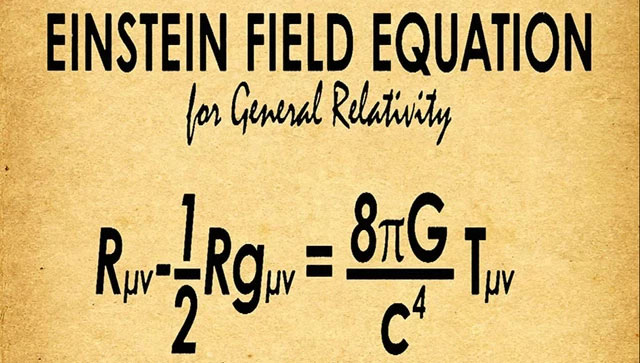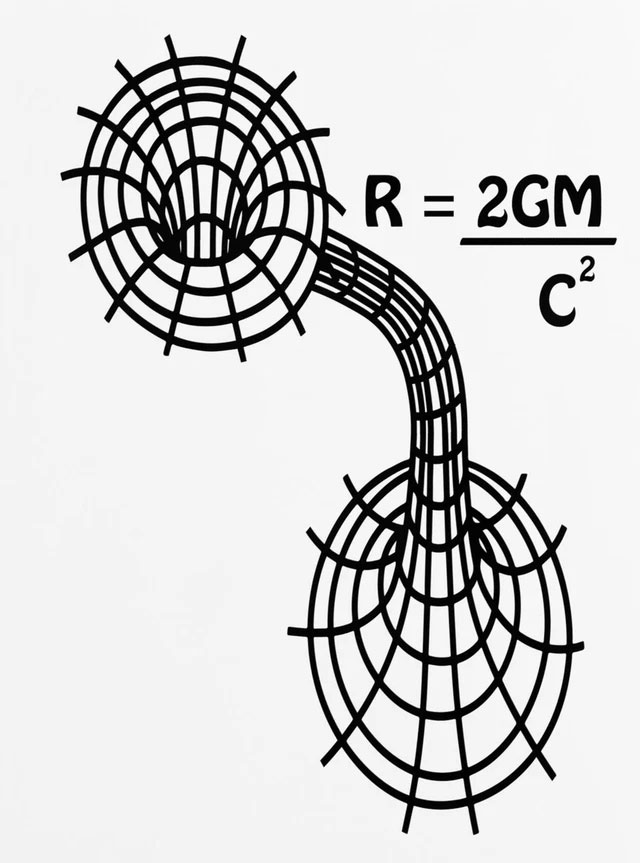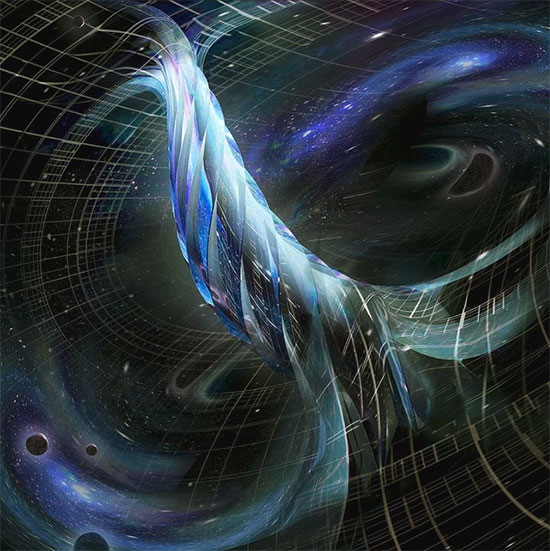The difference between the three polar holes in the universe: Black holes have been discovered, so where are white holes and wormholes?
So far, there has been a lot of evidence to show that black holes really exist, even in reality, but white holes and wormholes still exist only in theory.
Black holes, white holes and wormholes are all special phenomena in the universe. What they all have in common is that they are all extreme results caused by gravity and obey Einstein's gravitational field equation (referred to as field equation). The formula is shown in the following figure:

The derivation of this formula is very complex and will not be discussed here. Although these three "holes" are caused by the gravitational field, their properties are completely different. What they are and where they are hiding will be known after we learn these "holes" in turn.
Black hole
Simply put, a black hole is a strange phenomenon created by the compression of matter to its limit. In theory, any matter can be compressed to the limit, from atoms to planets, as long as the pressure is great enough, it can become a black hole. How big is this pressure? There is no specific value, but there is a formula for the limit to which a substance or object can be compressed.
This formula is the Schwarzschild radius formula, expressed as: R = 2GM/C^2. Here R is the Schwarzschild radius in meters, G is the gravitational constant, M is the mass of the object in kilograms, and C is the speed of light. This formula was devised in 1916 by astrophysicist Karl Schwarzschild, based on the gravitational field equations in Einstein's theory of general relativity.

Schwarzschild radius formula.
The meaning of this formula is: as long as any matter is compressed to the Schwarzschild radius by its own mass, it will undergo a strange change, all matter will inevitably fall to the point the core's singularity, and forming the spherical space limit by the Schwarzschild radius, this space has infinite curvature, any matter entering this space cannot escape, but can only fall down singularity in the center, even light is no exception.
How big is this Schwarzschild radius? According to the formula, the mass of a hydrogen atom is about 1.674*10^-27 kg and its Schwarzschild radius is about 2.48*10^-54m; the Sun's mass is about 2*10^30 kg, we get the Sun's Schwarzschild radius of about 2,964 m; The mass of the Earth is about 6*10^24 kg, the Schwarzschild radius value is about 8.9mm, which means that if you compress (shrink) the entire Earth into a marble with a radius of 8.9mm , it will turn into a black hole.

Black holes are a strange phenomenon created by the compression of matter to its limit.
Scientists believe that the Large Hadron Collider can create extremely small black holes on the atomic scale. However, this idea is only theoretical, and such small black holes have yet to be recorded in practice. According to the paper, many super-sized black holes were left behind in the Big Bang, and according to the Hawking radiation theory, atomic-sized black holes would evaporate instantly, so there hasn't been any so far. which super small black holes have been found.
In the universe, the smallest black hole recorded has a mass 3 times that of our Sun. These black holes are formed by uncontrolled thermonuclear fusion inside massive stars as they die, causing a supernova explosion. The extreme pressure compresses the core material into the Schwarzschild radius by its own mass, thus becoming a black hole.

It is generally believed that a star 30 to 40 times more massive than the Sun will directly turn into a black hole when it dies. In addition, cosmic black holes are also formed by the collision and accretion of massive bodies, which collapse and form black holes when they exceed the critical mass point. For example, through accretion, a neutron star with a mass exceeding the Oppenheimer limit would be compressed into a black hole.
Theoretically, the mass of a black hole lies above the singularity of the core and that singularity is infinitely small, so a black hole is understood as having infinitely small volume, infinite density, infinite curvature, and infinity. thermal limit. The premise of these four infinity is infinitely small volume, which leads to the appearance of the later three infinity.

The curvature of a black hole is infinite.
The curvature of a black hole is infinite, referring to the Schwarzschild radius, and its critical point is also known as the black hole event horizon. Here, curvature is the distortion of the surrounding space-time caused by mass, expressed as the force of gravity. In distant places, its gravity still obeys the law of universal gravitation, which is directly proportional to mass and inversely proportional to the square of distance, just like the gravity of any celestial body.
Since the gravitational force in the Schwarzschild radius of the black hole is infinite, any matter near the black hole will be "eaten", and there will be no way back, so the black hole will get bigger and bigger. . The largest black hole found in the universe is named SDSS J073739.96 + 384413.2, which has a mass of 104 billion times that of the Sun.
The process of neutron stars becoming black holes
Neutron stars are objects found in the universe with a density second only to black holes. They are mid- and large-mass stars - stars that are about 8 to 30 times the mass of the Sun. After a supernova explosion, the rest of the star is just a dense core.

Black holes are the final stages of a star's evolution.
The radius of this core is only about 10km, the density is as high as 1-2 billion tons/cm, and the surface pressure reaches 10^28 atmospheres, which is 33 trillion times greater than the pressure on the Earth's surface.
Because of the great gravity of neutron stars, they will continuously accrete nearby objects or interstellar matter to themselves, increasing their mass.
It can be said that a black hole is the final stage of evolution of a star (or any celestial body), i.e. when any celestial body reaches the top of its life cycle, it will become a black hole.
White Hole
A white hole is a theoretical conjecture that is the exact opposite of a black hole, it is just a mathematical model assumed by physicists based on Einstein's field equations. Until now, science still has no evidence to prove the existence of white holes. The basic definition of this model is that black holes will continuously devour cosmic matter, while white holes do the exact opposite, continuously hurling matter into the universe.

Until now, science still has no evidence to prove the existence of white holes.
In theory, black holes and white holes are the ultimate celestial bodies in the universe. The gravity of a black hole is infinite, and the repulsion of a white hole is infinite. Both have closed boundaries.
Since a white hole is just a hypothetical object that exists in theory, there are many different explanations for what causes white holes to form. And the most popular view is that the Big Bang of 13.8 billion years ago can be thought of as an event caused by a supermassive white hole.

There are many explanations for the formation of white holes.
In addition, there are several views: one, the white hole is the "retrograde" of the black hole, that is, when the black hole reaches its limit and collapses, it will undergo a qualitative change, energy conversion. internal accretion into energy ejected from the core; second, just like the existence of yin and yang matter in the universe, white holes and black holes are yin and yang holes in the universe, one that releases energy and the other absorbs energy, having opposite properties. opposite each other.
There is also the view that the matter absorbed by the black hole will be ejected from the white hole at the other end, and that the conduit between the black hole and the white hole is a wormhole. A black hole and a white hole can be in the same space-time, but two distant regions can be in two space-time with different properties.

Black holes and white holes can be in the same space-time.
However, so far, these are only hypotheses, as the actual existence of the wormhole has not been observed. So do wormholes exist? Hard to say. The greatest joy in scientific discovery is that theoretical predictions have finally been confirmed. This is how black holes and gravitational lenses are discovered, will white holes be discovered or ultimately negated? At the moment we still do not know the answer.
Worm Hole
The wormhole is also a prediction based on Einstein's field theory. The concept of "wormholes" was first proposed by Austrian physicist Ludwig Frahm in 1916. Later, physicists Einstein and Nathan Rosen perfected the theory, hence the name wormhole. is an "Einstein-Rosen bridge" or space-time tunnel, meaning a multidimensional space-time tunnel connecting two distant space-times.

The wormhole is like a tunnel for a highway or train to go through a mountain.
This space-time nexus is likely connected with the "baby universes", a period in which galaxies and stars were born shortly after the birth of the universe, 13.8 billion light-years away. light or more.
In the understanding of many people, a wormhole is like a tunnel for a highway or train to pass through a mountain. Without this tunnel, to get to the other side of the mountain, you would either need to climb over the top of the mountain or go through a lot of detours. Therefore, the wormhole is considered a "shortcut" for the existence of outer space.
With this shortcut, it is possible to make instant transfers of distant time and space, such as to "baby universes" quickly, and the time needed to reach the destination is relatively short, fast. many times faster than the speed of light.
But wormholes, like white holes, exist only in science fiction and theoretical conjecture, with no actual existence confirmed yet.
There are many theories about the cause of wormholes. For example, as mentioned earlier, there is a pipeline that transports matter between a black hole and a white hole, which is a wormhole; or the collision between a white hole and a black hole, will form a wormhole, etc.
In general, a wormhole is a space-time vortex formed under the influence of a giant gravitational field. The rotation of a huge mass of objects and the interaction process will distort space-time, forming a space-time vortex. This is a bit like a giant sea tornado, ubiquitous but fleeting. Some vortices can cause two distant parts to come very close together for a moment. This type of space-time vortex is called a "wormhole" in the universe.
Due to the uncertain nature of wormholes, even if wormholes are found to exist, whether they can be exploited remains controversial. Some believe that only negative energy or dark matter can keep a wormhole stable. But negative energy and dark matter are still only theoretical hypotheses for now. Therefore, the existence of the wormhole cannot yet be confirmed.
Summary
From the above introduction, we can see that black holes, white holes and wormholes are all "holes", but they are not ordinary holes, instead they are special celestial bodies. Basically, these three "holes" are all phenomena or existence caused by the gravitational field, but they have completely different properties, their influence and impact on the future of humanity is also different. together.

Black holes, white holes, wormholes are all special objects.
Now, scientists have taken the first pictures of a black hole with a lot of effort and expense, and confirmed the real existence of a black hole. However, white holes and wormholes only exist in the theoretical stage, whether they can be detected in the future and whether they can be used by humans remains uncertain.
However, it should be known that black holes in the past were merely unreliable theories, until science developed more in recent years.
- New hypothesis: Black holes in the universe turn into
- Discover the mystery of the most exotic black holes in the universe
- Unexpectedly discovered 5 mysterious black holes in the universe
- Decoding mistakenly thought that the black hole of the universe is
- Three huge black holes are about to collide in the universe
- Why can black holes glow?
- Why doesn't the black hole swallow the whole universe? This may be the answer!
- Millions of black holes are hiding in our galaxy
- What if a black-sized black hole attacked the Earth?
- The galaxy has 3 black holes
- A new discovery about the activity of a supermassive black hole in the early universe
- The universe will have the largest ever explosion of two black holes
 Van Allen's belt and evidence that the Apollo 11 mission to the Moon was myth
Van Allen's belt and evidence that the Apollo 11 mission to the Moon was myth The levels of civilization in the universe (Kardashev scale)
The levels of civilization in the universe (Kardashev scale) Today Mars, the sun and the Earth are aligned
Today Mars, the sun and the Earth are aligned The Amazon owner announced a secret plan to build a space base for thousands of people
The Amazon owner announced a secret plan to build a space base for thousands of people